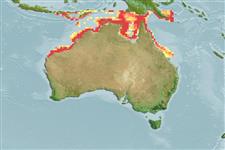Elasmobranchii (sharks and rays) >
Orectolobiformes (Carpet sharks) >
Hemiscylliidae (Bamboo sharks)
Etymology: Hemiscyllium: hemi-, from hemisys (Gr.), half, presumably referring to similarity and/ or close affinity to Scyllium (=Scyliorhinus, now in Scyliorhinidae) and/or Chiloscyllium; skylion, Greek for dogfish or small shark (See ETYFish); trispeculare: tri-, from tres (L.), three; specularis (L.), watchful or looking, referring to three eyespots (ocelli) on shoulder (See ETYFish).
More on author: Richardson.
Environment: milieu / climate zone / depth range / distribution range
Ecology
Marine; reef-associated; depth range 0 - 50 m (Ref. 54542). Tropical; 8°S - 22°S, 114°E - 152°E (Ref. 54542)
Western Pacific: northern Australia (including Western Australia) (Ref. 6871). Possibly in the Mollucas (Indonesia).
Length at first maturity / Size / Weight / Age
Maturity: Lm ?, range 53 - ? cm
Max length : 79.0 cm TL male/unsexed; (Ref. 43278)
Dorsal spines (total): 0; Anal spines: 0. Body covered with numerous, densely clustered dark, small and large spots that form a reticular network of light ground color between them; dark crossbands strong on ventral surface of tail (Ref. 13575).
Found on shallow coral reefs of the continental shelf (Ref. 247). Probably mainly feeding on benthic invertebrates (Ref. 6871). Oviparous (Ref. 50449).
Life cycle and mating behavior
Maturity | Reproduction | Spawning | Eggs | Fecundity | Larvae
Oviparous, paired eggs are laid. Embryos feed solely on yolk (Ref. 50449).
Compagno, L.J.V., 1984. FAO Species Catalogue. Vol. 4. Sharks of the world. An annotated and illustrated catalogue of shark species known to date. Part 1 - Hexanchiformes to Lamniformes. FAO Fish. Synop. 125(4/1):1-249. Rome, FAO. (Ref. 247)
IUCN Red List Status (Ref. 130435: Version 2024-1)
Human uses
Fisheries: minor commercial
Tools
Special reports
Download XML
Internet sources
Estimates based on models
Preferred temperature (Ref.
123201): 26.9 - 28.7, mean 27.9 °C (based on 210 cells).
Phylogenetic diversity index (Ref.
82804): PD
50 = 0.5020 [Uniqueness, from 0.5 = low to 2.0 = high].
Bayesian length-weight: a=0.00398 (0.00176 - 0.00901), b=3.09 (2.89 - 3.29), in cm total length, based on LWR estimates for this (Sub)family-body shape (Ref.
93245).
Trophic level (Ref.
69278): 3.5 ±0.37 se; based on food items.
Resilience (Ref.
120179): Low, minimum population doubling time 4.5 - 14 years (Fec assumed to be <100).
Fishing Vulnerability (Ref.
59153): Moderate to high vulnerability (52 of 100).
Nutrients (Ref.
124155): Calcium = 16.1 [3.1, 60.5] mg/100g; Iron = 0.407 [0.100, 1.103] mg/100g; Protein = 19.3 [17.1, 21.3] %; Omega3 = 0.0839 [, ] g/100g; Selenium = 28.1 [8.7, 78.1] μg/100g; VitaminA = 56.1 [19.8, 149.3] μg/100g; Zinc = 0.984 [0.482, 2.033] mg/100g (wet weight);
